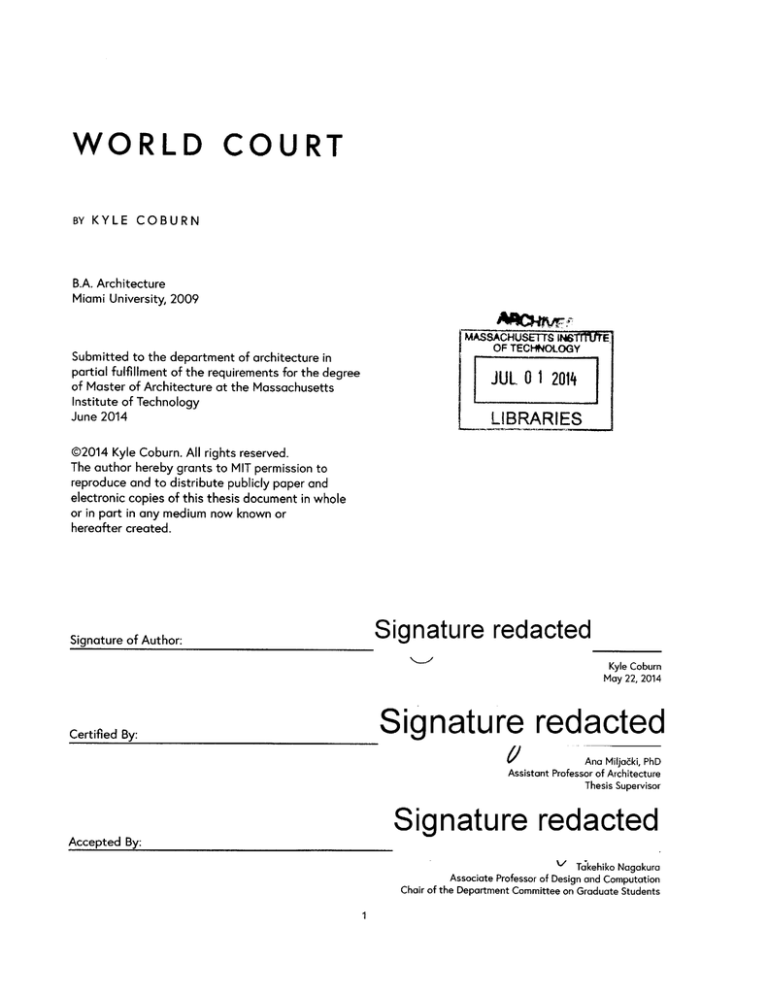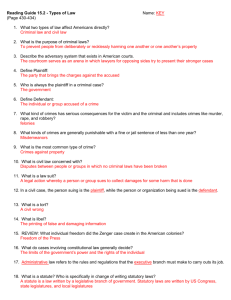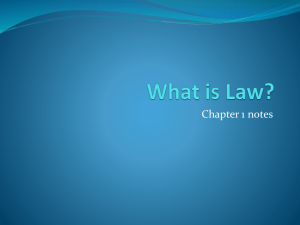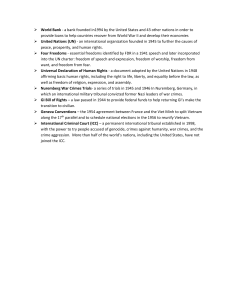
WORLD COURT
BY
KYLE COBURN
B.A. Architecture
Miami University, 2009
MASSACHUsWfSE
TIN1fdrE
OF TECHNOLOGY
Submitted to the department of architecture in
partial fulfillment of the requirements for the degree
of Master of Architecture at the Massachusetts
Institute of Technology
June 2014
JUL 0 1 2014
LIBRARIES
@2014 Kyle Coburn. All rights reserved.
The author hereby grants to MIT permission to
reproduce and to distribute publicly paper and
electronic copies of this thesis document in whole
or in part in any medium now known or
hereafter created.
Signature redacted
Signature of Author:
Kyle Coburn
May 22, 2014
Signature redacted
Certified By:
V
Ana Miljaeki, PhD
Assistant Professor of Architecture
Thesis Supervisor
Signature redacted
Accepted By:
Takehiko Nagakura
Associate Professor of Design and Computation
Chair of the Department Committee on Graduate Students
1
2
WORLD COURT
BY KYLE COBURN
Submitted to the department of architecture on
May 22, 2014 in partial fulfillment of the requirements
for the degree of Master of Architecture
ABSTRACT
Eighteen billion gallons of toxic waste, nine billion
dollars in damages, trials across five countries,
hundreds of lawyers, millions of dollars in litigation
fees, and a corporation with an annual revenue
of two hundred billions dollars-this is the story
of Texaco's drilling operations in the Lago Agrio
region of Northern Ecuador, referred to by locals as
"rain-forest Chernobyl". This thesis proposes that the
Lago Agrio case, and others like it highlight not only
environmental issues, but issues that fall under a
much larger umbrella of International Law.
Events such as: crimes against nature or
shared natural resources, crimes against labor,
crimes pertaining to uncoordinated attempts
at geoengineering, the development of harmful
synthetic biology and nanotechnology, would
not only implicate Western and developed, but
also corporations, special interest groups and
individuals. The thesis is literally cited in the
contemporary configuration of the International
Court and its Hague reality but it is conceptually
cited with a few towards this potentially
changing landscape of international law.
With its current cases myopically focused on
crimes of African warlords, the International
Criminal Court, seated in The Hague, has a
latent capacity to work in a new set of crimes of
international concern. There is a wide scope of
environmental, technological, political and economic
phenomena that are not yet part of our definition
of International Law. To consider these issues as
such, is to drastically rethink the institution of
International Law itself, and with it, this thesis
argues, the role of architecture in this new form of
(highly contentious) universality.
These crimes, ones that we are all victim to,
as well as implicated in, codify the new Global
Collective centered around the activities of the
Court, there is a multiplicity of vested interests,
and one of the key disciplinary questions the
thesis addresses is the form of monumentality
that this architecture could take given both
the multiplicity and scale of those interest-in
a climate in which neither the Western and
developed countries have the moral upper-hand
nor the survival of the planet seems a given.
Thesis Supervisor: Ana Milja~ki, PhD
Title: Assistant Professor of Architecture
3
4
COMMITTEE
Ana Miljaki, PhD
Assistant Professor of Architecture
J. Meejin Yoon
Associate Professor of Architecture
Timothy Hyde, PhD
Associate Professor of Architecture
Harvard Graduate School of Design
I
5
6
ACKNOWLEDGMENTS
This thesis in no way was produced single-handedly, it was the result something much larger
than myself. I sincerely thank the faculty and my
colleagues at MIT.
To Ana for your commitment to education above
all else and for knowing what I myself did not.
Your acute criticism was a true inspiration and it is
something that will stay with me for many years to
come. The way I think about architecture will never
be the same.
To Meejin, your criticism at direction came at the
most important times, the project would have not
been the same without you.
To Kyle, for your insight and help in the final push.
To Nico, Jason and Kristina for giving valuable time
on the model. To Kyle, John and Karina for your
continued friendship throughout our time at MIT.
To Elle and my parents, any attempt at thanking
you proves insufficient.
To God, any ability is not my own.
7
~w-
8
~
9
LAGO AGRIO
This thesis begins with Texaco drilling operations in the Lago Agrio region of
Northern Ecuador where, over a period of 20 yrs, the company released 22
Billion gallons of toxic waste across 1,700 sq miles of protected rainforest.
Obvious environmental impacts ensued: spikes in cancer deaths of the local
people, miscarriages, birth defects, dead livestock and native animals,
deforestations and the near-extinction of indigenous tribes.
10
LL
I1
This spawned a still ongoing 18 year litigation battle that has out-lived Texaco
itself as well as several judges involved in the original trials. Overall, the case
represented 30,000 plaintiffs, with hundreds of lawyers on both the defence
and prosecution side, resulting in 400 million of dollars in litigation fees a
year accruing by Chevron.
Allegations of bribery and corruption came from both sides, there were dozens
of "environmental experts" providing information as well as disinformation,
there was celebrity involvement, and a documentary entitled "Crude".
The first ruling of the case in Ecuador ordered Texaco to pay $18 billion in
damages to the local people, but this was later overturned in the United
States when evidence of judge bribery by one of the lead attorneys surfaced.
A truly international string of trials followed, with appeals from both sides in
Canada, Argentina, Brazil and The Netherlands.
The thesis argues that the LAGO AGRIO
case, and others like it highlight not only
environmental issues, but issues that fall
under a much larger umbrella of International
Law.
12
4PrP: p'i m
There is a wide scope of environmental,
technological, political and economic
phenomena that are not yet part of our
definition of International Law ...
14
To consid er these
issues as suc hI is to
drastically rethink
the I nstitution of
Internationa I Law
it s elf, and with
it , argued in this
project, the role
of architecture in
this new form of
(highly contentious)
universality.
15
I
. ..........
.
.
...
. .....
.
..............
. ......
tA
lk
t
HISTORY OF
INTERNATIONAL
IC
LAW
t ,
.11
y
lj
The first instance of what now can be described as International Law
came at the close of World War 11 with the Nuremberg trials tasked with
the prosecution of twenty-three prominent members of Nazi Germany. This
coincided with its mirror, the Tokyo Tribunals.
16
. .........
I.
>
20~~~~~~
RAiOA
RMN
l PN
lOR
e c.
Then there was a fifty year gap before the next instance of an international
court, the first was the tribunal for the Former Yugoslavia, followed by Rwanda,
Cambodia, Sierra Leone and Lebanon. The International Criminal Court, on
which this project is based, was established in 2002 and is the first court of
its kind not to be situation specific.
17
I
...
.......
-, 1111
- -
t
E
WHO'S IN?
-- ----
-
-
-- -
- - - - - 1
The international criminal court has been
critiqued extensively for its current and
historical international representation.
1C
18
.4
In order for a country to fall under the jurisdiction of the Court, a state must
first ratify the ruling document of the ICC, The Rome Statute, which entered
into force in 2002. Currently, 122 states have ratified the statute, however
these states only account for approximately 33% of the worlds population.
India, China, Russia and the United States do not recognize the Court and
therefore are outside of its jurisdiction.
19
t
E
U
CURRENT ICC
Severe problems with the ICC emerge in the location of the current cases,
SITUATIONS
all of which are in Africa. These cases are for crimes of "utmost international
concern" including crimes of genocide, crimes against humanity and war
crimes.
20
N=
I
DEMOCRATIC REPUBLIC OF THE CO
A clear instance of Western colonialism.
21
I
t t t tt Ottt t ttt t ttt tt ttt
t 11111
tttt
1111111
t
MIt
t 111
REPRESENTATION
t t t1t11t11t11t1
tI t111ttt
t t t tI t t tI tI
1t
It
t
I
tt
t
tt
Changes have been attempted by the Court in light of accusations of Western
biases. Each member state is allowed one representative to form a General
E
U
Assembly tasked with the election of the Chief Prosecutor, Judges, President
and Head Registrar. Fatou Bensouda, a lawyer from the Gambia, was elected
in 2012 to act as the second Chief Prosecutor for the ICC. This marks a small
improvement considering 53% of the current judges still come from European
Union countries.
22
23
FINDING /
CASE REFERRAL
Primarily Western funding continues to question the nature of the institution,
as does the means by which cases are referred to the Court-one of which
is the UN Security Council where the United States, Russia and China are
permanent members, yet these countries themselves are not party to the
Court and are therefore outside of its jurisdiction.
24
f4.,
-
3PPuM
U>)
This thesis
proposes a new
set of crimes that
s hould faI I under
the jurisdiction of
t he I nternational
Criminal Court
d
U
0
E
26
27
FUKUSHIMA
NUCLEAR
NEGLECT
28
RUSSIA'S CLAIM
TO THE NORTH
POLE SEABED
29
BANGLADESH
FACTORY
COLLAPSE
30
I
UNCOORDINATED
ATTEMPTS AT
GEO-ENGINEERING
31
ALBERTA CANADA
TAR SANDS
32
I
BP GULF OIL SPILL
33
UNITED STATES
DRONE ACTIVITY
34
I
RESEARCH AND
DEVELOPMENT OF
SUPER-VIRUSES
35
seen as crimes
these events would
if
not only implicate
Western and
developed, but also
corporation s special
interest groups and
individua I s.
I
36
The thesis is literally cited in the
contemporary configuration of the
International Court and its Hague
reality but it is conceptually cited with
a few towards this potentially changing
landscape of international law.
37
FA
4!L
1
'pr
op
I
38
Chevron
VS
If Chevron, or a similar multi-national
corporation, was one day in the near
future held responsible for its
environmental crimes, what exactly would
be the nature of this trial?
39
I
CURRENT
CONFIGURATION
Since its establishment in 2012 the ICC has temporarily been housed in a
banal office building in the Hague. This building in no way is suited to the
specific needs of the court with the courtrooms occupying a retrofitted parking
garage located in the back of the building.
40
Nothing about the current ICC configuration accounts for the huge defence
teams, high profile CEOs, hundreds of "experts", public protests, international
public interest, broadcasting requirements, decade-long trials, biased
interests the caould be expected in these new types of international trials.
41
In a climate in which neither the Western and
developed countries have the moral upperhand nor the survival of the planet seems
a given-these crimes, ones that we are all
victim to, as well as implicated in, codify the
new Global Collective centered around the
activities of the Court-there is a multiplicity
of vested interests.
42
One of the key
disci plinary
questions the
t hesis addresses
is the form of
monume ntality that
this architecture
could take given
both the multip IIcity
and scale of those
interests.
43
I
THE ANTI-
GLOBALIZATION
MOVEMENT
In trying to gauge who might physically make up the collective that would visit
ICC's current but perhaps soon to be anachronistic location in the Hague, the
key precedent was the Anti-Globalization movement, which involved a series
of protests in the early 2000s executed against meetings of the G8, World
Trade Forum and World Economic Forum. The Anti-Globalization movement
was an example of both a physical and networked global public.
44
|| 1El
There could be extracted a number of common characteristics in the way these
people gathered in terms of numbers, but also how they produced effects:
street blockades, sound disruption, volume/mass of people blockades,
spectacles (burning cars, banners), extended protests (camping, sit-ins),
cultural draws (concerts, speakers, public forums).
45
I
THE HAGUE
The site remains in the Hague where there exists an unusually high
concentration of international institutions, not all associated with
International Law. International tribunals located in the Hague include: Former
Yugoslavia, Sierra Leone and Lebanon-each occupying their own building. Also
in the Hague is the UN Judicial branch, the International Court of Justice,
which holds jurisdiction in state-to-state disputes.
46
INTERNATIONAL CRIMINAL TRIBUNAL
INTERNATIONAL COURT OF JUSTICE
FOR THE FORMER YUGOSLAVIA
PEACE PALACE
INTERNATIONAL CRIMINAL COURT
INTERNATIONAL CRIMINAL TRIBUNAL
FOR SIERRA LEONE & LEBANON
I
47
48
THE PEACE PALACE
The ICJ is housed in the Peace Palace, which was constructed in 1913 by
Andrew Carnegie, described as a "temple of peace . . . a holy place ...
an outward and visible sign . . . and a tangible existence known to the
ends of the earth." Peace as totalitizing object.
49
The project is
positioned to be in
conversation with
the Peace Palace,
addressing the role
of the specific local
and more global
notion of the square,
both a s a form
and as a place of
gathering.
50
51
EMIn
wQ
(F
I
-
-To
CORBUSIER
The project situates itself within the lineage of Corbusier, particularly in
his changing attitudes towards form. In this progression from his proposal
for the UN Headquarters to the reconstruction of St. Die, there is a shift in
an attitude of civic space being defined by means of totality, a clear single
I.-
object (in the UN) to an increasingly loose composition of buildings, where
civic is defined more by fluid space than by a single totalitizing perspective.
52
N*
UNITED NATIONS
In relation to this are the design proposals of the UN headquarters in
H EADQUARTERS
New York, where there is again, a certain totality being represented with
relation to the square.
53
I
N
Nk 1r
4N i4
~N~L
.N
ilk.
CORBUSIER
Under the idea of totality can also be positioned a number of historic squares
and sites of gathering, Tiananmen Square, Zocalo Mexico City, Tahrir Square
(produced as voids) -or, Kahns Parliament in Bangladesh and the Peace Palace
(monumental square as massing).
54
1
-q2%!h.
~N'I
The project operates somewhere in between
these precedents, not re-cooperating the
square in the historical sense, but also not
resorting to the Modernist plaza.
55
The square within the context of the project
is one of uncertainty and conflict and can be
seen as operating within a set of binaries or
at least pairings. Depending on the site and
context, begins to flicker between the two:
56
Irrelevant and
Monumental
Commenting and
Re-cooperation
Stand-In and Object
Discharged and
Charged
Networked and Local
Present and Empty
57
I
The project operates as an object in response
to other objects, playing with the inability or
ability so understand its totality.
58
SITE STRATEGY
On the outside, the massing responds to its context as a series of rotating
volumes strung off of a central void. Any notion of a constitution as an
object from the exterior is completely undermined by the void. The project
is much less definitive and certain object that its predecessors.
59
I
The void is
meant to
resonate
with other
t hings like it
globally.
60
61
REMOTE EVENTS
The void could literally help set up a network of remote events happening
somewhere else with respect to the court. In some cases, the urban fabric
already has a history of gathering or it inherently provides this site of
gathering. In others sites, the delayed square is what allows for gathering
and enables the capacity to produce effects.
62
I
63
I
64
The network,
and forms of
organizational
and architectural
redundancy is an
Inevi tab le dim ension
into whi ch the I cc
would have to move
post its Hague
phase.
65
I
FIGURE / GROUND
PLANS
In each individual plan a tension is produced between void and program
volume-the void that anchors them also completely undermines them. The
rotations occur in opposing directions to produce differing effects. Although
The plans are stacked, they produce very different elevations, again, to
undermine the certainty and totality of the object.
66
67
I
68
'///~
69
ROOF PLAN
The plans are organized according to a series of transactions for which they
contain: Security/Entrance, Gathering (Courtrooms), Waiting, Administration
and Research. The relationship to the central void establishes a strategy to
space make in plan, the thin band along the void extends and expands into
the program volume to serve as a primary organizer. This establishes a certain
grain to which the plans become organized against.
70
RESEARCH
This plan holds both the judge and prosecutor offices. There maintains
a central shared "War Room" used as an overview space for current and
future situations. The prosecution is organized as a series of trays that
can be occupied by various teams working on separate situations. The
judges are organized as a series of individual offices, which a central
"Skype" room for networked meetings.
71
1111 NINE
\HER .NOWN11111
4-
ADMINISTRATION
This plan is punctuated by a series of light wells and is stitched together
with one continuous desk corresponding to the ramped central circulation.
Also occupying this plan are the archival support spaces. The archive occupies
the this band lining that central void, assuming a sort of monumentality. All
programs require access to the archive, and it is continuous across the entire
project volume, rotating in relation to the plans. The archive is seen as a place
of research and memory, with facilities for researchers to come research and
document the proceedings of the court.
72
I II
a-
i
HA
IIIl~
U
I
I
I
I
LIVING
This plan supports life and speaks to the extended temporal nature of
the trials, with the potential to continue for months and even years.
Accommodations are provided for both judges coming on specific cases,
as well as for the subjects on trial. These two living quarters are selfsimilar in volume and massing, with each one providing specific programs
for the persons occupying them:
Judge Quarters: Bar doubling as VIP room, sauna, exercise area, library,
access to the archive, full apartments, concierge.
Criminal Quarters: Putting green, shared kitchen, common area, security
guards, conjugal room, visiting children's room.
73
U
COURTROOMS
The three courtrooms are given as identical volumes, taking an ideal form
that is part of a larger historical lineage. The public viewing extends out from
courtroom and can be occupied to various capacities depending on the size
of the trial.
74
A'
SECURITY /
ENTRANCE
Occupying the ground plan are the security facilities and main public
entrances to the Court. A large portion of this plan is evacuated in order
to facilitate a public gallery of the current situations on trial. The gallery
is organized as a series of bands that correspond to each case, both the
prosecution and defence curate a wall of this exhibition space providing
grounds for both information and disinformation.
75
I
-A
-
f
MUOr-3
~
-A~C
1A
1t
2z'
42\
14
77
A series of
erosions are
planned to
destabil ize
the project
over time
sectionally.
I
78
I
79
I
FIGURE / GROUND
SECTIONS
The erosions are facilitated by a material uncertainty that allows the project
to become eroded and undermined throughout the occupation of the project.
These erosions are considered temporally and increase in severity the longer
the building is in use-the erosions occur as a result of the occupation of people
as well as through the increasing toxicity in the air. The erosive surfaces are
also where the public enters the project, they are entirely unmediated by the
court and provide a space of irresolution and conflict, allowing the public
to produce effects, learning form the examples of the Anti-Globalization
movement.
80
--
moomm
I
81
I
PRIMARY SECTION
Seen here is the central erosion occurring over courtroom and the
corresponding erosions on all subsequent volumes. The underbelly of the
courtroom volume is carved away as to allow for views directly into the
courtroom from the outdoor public plaza. This view corridor continues to
link with the public surface on the opposing volume. Lining the void, pubic
circulation links the stacked public erosion planes, this coincides with the
archive occupying same narrow portion of the plan.
82
T.
---
4
---------
Ir ell
Servers are positioned under the plaza heating the surface in the winter and
the underground portion also serves as the primary entrance for the various
subjects of the Court accessed by car. The building concedes a portion to
allow for the occupation of a public stage addressing the plaza at the base
of the void.
83
-I
84
7 7,
77"
I
85
I
86
L9
I
I
88
I
89
The erosions
allow
architecture
to respond to
the entropic
dissolution of
the planet.
90
The very act of the public coming to the
court, as well as the environmental toxins
that the court is attempting to abate,
ultimately aid in the Courts architectural
destruction.
91
F
I
93
The project
end s with the
building in its
dysfunctional
state whether
t he Court
S ucceeded
to fai Ied is
unc Iear
I
94
95
96
97
98
BIBLIOGRAPHY
Bourriaud, Nicolas. Relational Aesthetics. Dijon: Leses Du R6el, 2002. Print.
Coll, Steve. "When a Criminal Leads a Country." The New Yorker. N.p., n.d. Web.
01 May 2013.
Keefe, Patrick Radden. "Reversal of Fortune." The New Yorker. 9 January 2012.
Print
Latour, Bruno, and Peter Weibel. Making Things Public: Atmospheres of
Democracy. Cambridge, MA: MIT, 2005. Print.
Lyotard, Jean-Frangois. The Differend: Phrases in Dispute. Minneapolis: U of
Minnesota, 1988. Print.
Mouffe, Chantal, Elke Wagner, and Chantal Mouffe. Agonistics: Thinking the
World Politically. N.p.: n.p., n.d. Print.
Schabas, William. An Introduction to the International Criminal Court.
Cambridge, UK: Cambridge UP, 2004. Print.
Schiff, Benjamin N. Building the International Criminal Court. Cambridge:
Cambridge UP, 2008. Print.
Serenyi, Peter. "Le Corbusier's Changing Attitude toward Form." Journal of
the Society of Architectural Historians 24.1 (1965): 15-23. JSTOR. Web. 22
May 2014. <http://www.jstor.org/stable/10.2307/988274?ref=search-gateway:098b50c98b4bd3c51 bc91f772652d687>.
99
0




